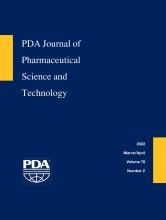Abstract
Pre-filled syringes have simplified parenteral administration of protein drugs. To ensure an easy and consistent movement of the plunger, the inner glass container surface is typically siliconized. For bake-on siliconization, emulsions are sprayed on and heat treated. Due to the European Union regulation REACh (Regulation concerning the Registration, Evaluation, Authorisation and Restriction of Chemicals) the use of certain emulsion components, partially constituting the gold standard LiveoTM 365 35% Dimethicone NF Emulsion (LiveoTM 365), becomes restricted and LiveoTM 366 35% Dimethicone NF Emulsion (LiveoTM 366) has been introduced as an alternative. This change may affect the handling properties as well as the silicone layer formed. The purpose of these studies was to identify any differences that may influence the stability and safety of the final drug/device combination product to enable the use of the new emulsion. We compared silicone emulsions LiveoTM 365 and LiveoTM 366 and dilutions focusing on 1) their general physical stability, 2) the thermal degradation process of the emulsions and their components, and 3) the resulting silicone layer concerning chemistry, morphology, and functionality. The results were linked to the assessment of the final product regarding particle formation and short-term stability. A comparison of the emulsions LiveoTM 365 and LiveoTM 366 for bake-on siliconization is presented to support the transition of the latter as it becomes mandatory with REACh. Our studies show that the two emulsions do not significantly differ with respect to handling and stability, the resultant silicone layer characteristics as well as its functionality. We conclude that the transition to the new emulsion will not significantly impact the final product or the layer performance upon storage and with respect to particle formation.
- Bake-on siliconization
- Protein formulation
- Drug/device combination product
- Primary packaging
- Biopharmaceuticals
- Silicone interaction
- Silicone layer characterization
- © PDA, Inc. 2022
PDA members receive access to all articles published in the current year and previous volume year. Institutional subscribers received access to all content. Log in below to receive access to this article if you are either of these.
If you are neither or you are a PDA member trying to access an article outside of your membership license, then you must purchase access to this article (below). If you do not have a username or password for JPST, you will be required to create an account prior to purchasing.
Full issue PDFs are for PDA members only.
Note to pda.org users
The PDA and PDA bookstore websites (www.pda.org and www.pda.org/bookstore) are separate websites from the PDA JPST website. When you first join PDA, your initial UserID and Password are sent to HighWirePress to create your PDA JPST account. Subsequent UserrID and Password changes required at the PDA websites will not pass on to PDA JPST and vice versa. If you forget your PDA JPST UserID and/or Password, you can request help to retrieve UserID and reset Password below.






